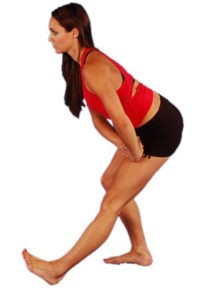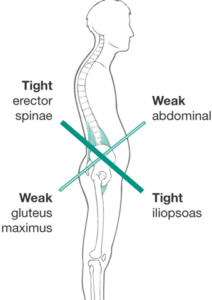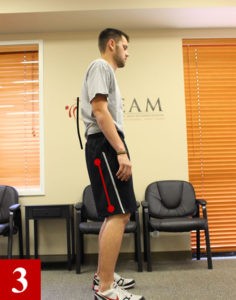Tight hamstrings!!
 “Why are my hamstrings always so tight, I stretch them all the time?”
“Why are my hamstrings always so tight, I stretch them all the time?”
A common question we get from patients all the time. You can have tightness in the hamstring area for a multitude of different reasons such as posture/pelvic positioning, neural tension, disc herniations, or previous hamstring injury. The most common reason we see in office is hamstring tightness as a protective mechanism for their posture and pelvic position.

This is a common posture we see in office. In this position the hamstring
is actually in a constantly stretched position making the hamstring feel tight. The hamstring is long and tight as compared to short and tight. This tilted forward posture of the pelvis puts the hamstring on constant tension, Further stretching in this position has no benefit and may actually predispose us to future injuries.
Below is a picture of someone who would have a short and tight hamstring and might actually benefit from stretching the hamstring. Thier pelvic position is in a sad dog or plummer posture. We ideally want to be somewhere in between these two extremes, in what is called a “neutral posture” Based on your skeletal development will determine your neutral.

The hamstrings originate at the bottom of the pelvis, so when we have instability in our pelvic or core area the hamstrings can also tighten down to act as a protective mechanism to stabilize this area. They are tight because they are protecting us and working overtime. In order to fix our constant hamstring tightness we need to work on building strength and endurance in neutral pelvis and spine positions. Rehab exercises, chiropractic adjustments, acupuncture, and soft tissue work through the hip flexors and pelvis can help to regain proper pelvic motion and control.
Below is a simple hip flexor stretch. When done properly for the right patient this can immediately relieve hamstring tightness. In this pelvic position the hip flexors are short and tight and the hamstrings long and tight. Getting more length in the hip flexor will help to begin the process of re-establishing proper length to both muscles.
The next thing we want to work on in this newly acquired neutral pelvic position is using the right exercises to begin strength and endurance training of the glutes and core musculature. Here is an example of a glute bridge progression.
Many patients will feel the glute bridge exercise in their hamstrings or low back compared to the glutes. If this happens to be you, this is not the right exercise for you at this time and we need to work to establish proper glute function. If you are constantly over-using your hamstrings to extend your hip when running, lifting, walking, glute bridges, etc the hamstring will always be tight and prone to injury. Re-establishing proper glute and core function is necessary for performance and ridding you of your hamstring tightness.
Just because it feels tight, doesn’t always mean stretching is the answer. Always ask the question why is it tight in the first place? If stretching doesn’t improve your range of motion and get rid of your tightness, then something else is going on, and make sure to get evaluated.
– Dr. Ryan Dunn D.C.
